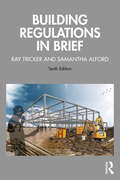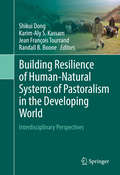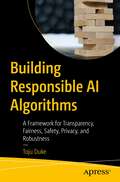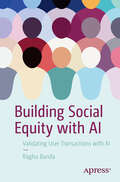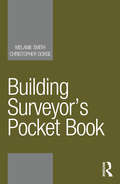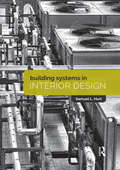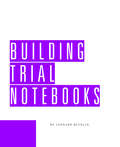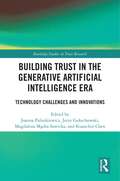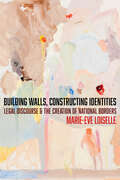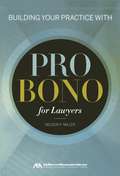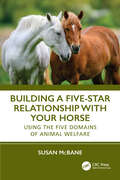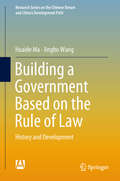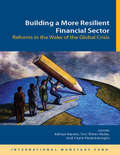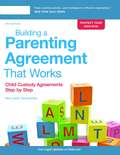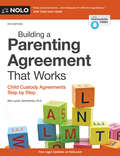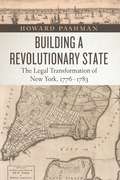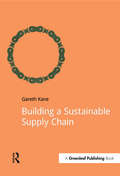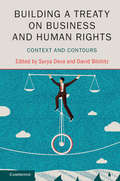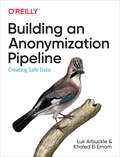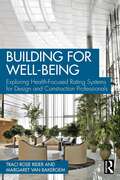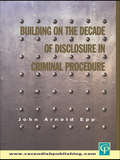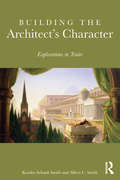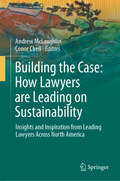- Table View
- List View
Building Regulations in Brief
by Ray Tricker Samantha AlfordThis tenth edition of the most popular and trusted guide reflects all the latest amendments to the Building Regulations, planning permission and the Approved Documents in England and Wales. This includes coverage of the recent changes to use classes, updated sections on planning permission, permitted development and application fees. We have included the revisions to Approved Document B (as a result of the Hackitt Review), as well as the latest changes to Approved Documents F and L, and the new documents O (overheating) and S (electric vehicle charging points), which come into effect in June 2022. Giving practical information throughout on how to work with (and within) the Regulations, this book enables compliance in the simplest and most cost-effective manner possible. The no-nonsense approach of Building Regulations in Brief cuts through any confusion and explains the meaning of the Regulations. Consequently, it has become a favourite for anyone working in or studying the building industry, as well as those planning to have work carried out on their home. It is essential reading for all building contractors and subcontractors, site engineers, building engineers, building control officers, building surveyors, architects, construction site managers and DIYers.
Building Resilience of Human-Natural Systems of Pastoralism in the Developing World: Interdisciplinary Perspectives
by Shikui Dong Karim-Aly S. Kassam Jean François Tourrand Randall B. BooneThis edited volume summarizes information about the situational context, threats, problems, challenges and solutions for sustainable pastoralism at a global scale. The book has four goals. The first goal is to summarize the information about the history, distribution and patterns of pastoralism, as well as to identify the importance of pastoralism from social, economic and environmental perspectives. The results of an empirical investigation of the environmental and socio-economic implications of pastoralism in representative pastoral regions in the world are also incorporated. The second goal is to argue that breaking coupled human-natural systems of pastoralism leads to degradation of pastoral ecosystems, as well as to create an analysis framework to assess the vulnerability of worldwide pastoralism. Our analysis framework provides approaches to help comprehensively understand the transitions and the impacts of human-natural systems in the pastoral regions in the world. The third goal is to identify the successful models in promoting coupled human-natural systems of pastoralism and to learn lessons of breaking coupled human-cultural pastoralism system through examining the representative cases in regions including Central Asia, Southern and Eastern Asia, Northern and Eastern Africa, European Alps and South America. The fourth goal is to identify the strategies to build the resilience of the coupled human-natural systems of pastoralism worldwide. We hope that our book can facilitate the further examination of sustainable development of coupled human-natural systems of pastoralism by providing the summaries of existing data and information related to the pastoralism development, and offering a framework for better understanding and analyzing their social, economic and environmental implications.
Building Respected Companies
by Jordi CanalsThe current financial crisis has deep macroeconomic roots, but the dominant view of the firm has made the crisis deeper and more devastating. Over the past few decades, maximizing shareholder value has become the main objective of the firm. Chief executives have been keen on this objective because their economic incentives have been clearly associated with stock market performance. Unfortunately, this has driven many CEOs to make terrible decisions based on short-termism and greed. In this way, the firm has become the object of anger, criticism and cynicism. In Building Respected Companies, Jordi Canals argues that we must address this problem by developing companies that serve society, not just their shareholders. This requires a new perspective of what a firm is, what the purpose of the firm in society should be and what the role of the board of directors and senior executives should be.
Building Responsible AI Algorithms: A Framework for Transparency, Fairness, Safety, Privacy, and Robustness
by Toju DukeThis book introduces a Responsible AI framework and guides you through processes to apply at each stage of the machine learning (ML) life cycle, from problem definition to deployment, to reduce and mitigate the risks and harms found in artificial intelligence (AI) technologies. AI offers the ability to solve many problems today if implemented correctly and responsibly. This book helps you avoid negative impacts – that in some cases have caused loss of life – and develop models that are fair, transparent, safe, secure, and robust.The approach in this book raises your awareness of the missteps that can lead to negative outcomes in AI technologies and provides a Responsible AI framework to deliver responsible and ethical results in ML. It begins with an examination of the foundational elements of responsibility, principles, and data. Next comes guidance on implementation addressing issues such as fairness, transparency, safety, privacy, and robustness. The book helps you think responsibly while building AI and ML models and guides you through practical steps aimed at delivering responsible ML models, datasets, and products for your end users and customers. What You Will LearnBuild AI/ML models using Responsible AI frameworks and processesDocument information on your datasets and improve data qualityMeasure fairness metrics in ML modelsIdentify harms and risks per task and run safety evaluations on ML modelsCreate transparent AI/ML modelsDevelop Responsible AI principles and organizational guidelinesWho This Book Is ForAI and ML practitioners looking for guidance on building models that are fair, transparent, and ethical; those seeking awareness of the missteps that can lead to unintentional bias and harm from their AI algorithms; policy makers planning to craft laws, policies, and regulations that promote fairness and equity in automated algorithms
Building Social Equity with AI: Validating User Transactions with AI
by Raghu BandaDid you ever think that the way you interact with other human beings, entities, and organizations can be measured for building a harmonious society? In this age of user verification and user validation, AI will fine-tune these interactions and transactions to build a socially equitable world. This book reveals that social equity is not only what you get from society, but also what you give to it. You’ll explore the concepts and intricacies of this mutually built phenomenon. The book then and focuses on creating social equity awareness and details how AI can help in the process. Regular enterprises, consumer-oriented companies, and social media companies all capture data in regular interactions and use this information in various ways. You’ll learn how this information is being leveraged and explore how social equity can thrive when all this information is analyzed and measured.Building Social Equity with AI highlights the subtle nuances of social equity and howAI can create more awareness towards it, thus improving your business or organization.What You’ll LearnUnderstand how social equity affects all business and industry professionalsBuild social equity into a changing worldSee how AI and GenAI stand out as transformative forcesIntegrate social equity into network structuresAddress equality and equity in the context of people, processes, and technologyWork with AI to improve social equity scores Who This Book Is ForSmall-medium business owners and users, consultants, education specialists, career coaches, data engineers, and social workers who want to leverage AI to gain social equity for either their business or personal life.
Building Surveyor’s Pocket Book (Routledge Pocket Books)
by Melanie Smith Christopher GorseBuilding Surveyor’s Pocket Book is an accessible encyclopaedia of matters vital to building surveyors. Well-illustrated with diagrams, pictures, tables, and graphs, it covers all essential elements of building pathology, building performance, and building construction terminology in a simple, accessible way for the practitioner and student. This Pocket Book provides a practical and portable reference text, working as a first-stop publication for those wishing to refresh their knowledge or in need of guidance on surveying practice. Working through fundamental principles in key practice areas, the book is not overly bound by the regulation and legislation of one region, and the principles can be applied internationally. This book is ideal reading for individual surveyors, practitioners, and students in building surveying, facilities management, refurbishment, maintenance, renovation, and services management. It is also of use for those interested in building forensics, building performance, pathology, and anyone studying for their RICS APC. Many other professions in architecture, contracting, engineering, and safety will also find the book of use when undertaking similar practice.
Building Systems in Interior Design
by Samuel L. Hurt<p>Building Systems in Interior Design takes an entirely new approach to teaching this essential topic for Architects, Designers and Building Engineers. Written to prepare students for the real world and packed with practical examples, the book will foster an understanding of specific issues that are critical to those features of technical systems that most directly affect design. The book stresses the ever-present nature of these systems: they are everywhere, all the time. <p>Taking a design oriented view, it outlines what can and cannot be done, and provides the student with the know-how and confidence to defend and promote their design intent when working with other industry professionals. <p>Covering lighting, HVAC, plumbing and much more, the book is packed with key features to aid learning including: <p> <li>Numerous illustrations, plans and photographs <li>Key terms defined in an extensive glossary <li>Chapter introductions that identify key concepts and chapter summaries to re-visit those key concepts <li>Professional design tips <li>And a detailed bibliography and web links</li> <p> <p>This book is not only a core text for interior design, building systems engineering and architecture students but will become an essential working reference through their careers.</p>
Building Trial Notebooks
by Leonard BucklinLeonard Bucklin's proven and highly-visible approach to litigation preparation will ensure that your cases and you are always ready for the next skirmish... even when unanticipated issues and arguments arise. Mr. Bucklin, who has been identified by the International Academy of Trial Lawyers as one of the top 500 trial lawyers in the U.S., created and polished his litigation preparation system over decades of high-stakes trial work. Now the Bucklin system is available to help you: Plan all aspects of your case so you hit every important point Organize your case from opening to closing Materially reduce your trial preparation time Assemble any case at low cost Keep each document at your fingertips Place litigation matters on staff auto-pilot Keep opposing counsel on the defensive Earn the respect of the court and opposing counsel with your organization and readiness The Bucklin litigation preparation system will also make you and your case settlement-ready. And your readiness, confidence, and organization will be visible. At depositions and conferences, defense counsel will see that you are prepared and focused, your trial notebook is steadily growing in size and value, and your strategies and forms are painfully effective.
Building Trust in the Generative Artificial Intelligence Era: Technology Challenges and Innovations (Routledge Studies in Trust Research)
by Jerzy Gołuchowski Joanna Paliszkiewicz Kuanchin Chen Magdalena Mądra-SawickaIn an era where generative artificial intelligence (AI) is reshaping industries and daily life, trust has become a cornerstone for its successful adoption and application. Building Trust in the Generative Artificial Intelligence Era: Technology Challenges and Innovations explores how trust can be built, maintained, and evaluated in a world increasingly reliant on AI technologies. Designed to be accessible to a broad audience, thi book blends theoretical insights with practical approaches, offering readers a comprehensive understanding of the topic.This book is divided into three parts. The first part examines the foundations of trust in generative AI, highlighting trends and ethical challenges such as "greenwashing" and remote work dynamics. The second part provides actionable frameworks and tools for assessing and enhancing trust, focusing on topics like cybersecurity, transparency, and explainability. The final section presents global case studies exploring university students' perceptions of ChatGPT, generative AI's applications in European agriculture, and its transformative impact on financial systems.By addressing both the opportunities and risks of generative AI, this book delivers groundbreaking insights for academics, professionals, and policymakers worldwide. It emphasizes practical solutions, ensuring readers gain the knowledge needed to navigate the evolving technological landscape and foster trust in transformative AI systems.
Building Walls, Constructing Identities: Legal Discourse and the Creation of National Borders (The Cultural Lives of Law)
by Marie-Eve LoiselleStates are erecting walls at their borders at a pace unmatched in history, and the wall between the United States and Mexico stands as an icon among these dividing structures. Much has been said about the US-Mexico border wall in the last few decades, yet American walling projects have a much longer history, dating back almost a century. Building Walls, Constructing Identities offers a rich account of this legal history, informed by two episodes of wall-building—the Act of August 19, 1935, and the Secure Fence Act of 2006. These two legislative periods illustrate that today's wall imprints onto the landscape a grammar of racial inequality underpinned by a settler colonial rationality. Marie-Eve Loiselle argues in favor of an account of the law that considers its material translation into space and identifies discursive processes by which the law and the wall come together to communicate legal knowledge about territory and identity.
Building Your Practice with Pro Bono for Lawyers
by Nelson P. MillerLawyers know that pro bono service is often the most interesting and fulfilling work of their careers. Yet few understand the financial and career benefits that pro bono work can yield. Building Your Practice with Pro Bono for Lawyers explains 10 pro bono opportunities that will broaden, deepen and strengthen your paying practice and legal career. Nelson Miller, an experienced pro bono practitioner, offers practical advice about helping underserved populations such as veterans, prisoners, immigrants, needy children, the homeless, and people with disabilities. This book will help you: * Develop the inter-cultural skills to serve pro bono clients * Learn from other lawyers by sharing pro bono cases * Gain new confidence and skills doing pro bono work * Fulfill your interest in specific pro bono client populations * Serve charitable organizations promoting pro bono * Comply with ethics rules governing pro bono work * Rejuvenate your paying practice through pro bono
Building a Five-Star Relationship with Your Horse: Using the Five Domains of Animal Welfare
by Susan McBaneThe Five Domains of Animal Welfare, when applied to horses, can act as a safe, reliable source of advice and information for conscientious owners, and also a benchmark by which the practices of the more experienced can be measured, scrutinised and held to account. They provide standards to be met rather than levels to be tolerated.This book explains, in accessible, everyday language, how to apply the Five Domains throughout the horse world, whatever type of equine is concerned or whatever role he or she fulfils, from pet to Thoroughbred racehorse, from informal friend and hack to Olympic competitor. The Domains have been expertly devised, carefully constructed and logically categorised so that anyone can find trustworthy advice on just about any problem or issue they are likely to meet in their lives with horses.Looking after a horse properly is an excellent way of preventing problems in the first place, and this book provides reliable information on knowing how to assess a horse on a daily and weekly basis so that owners will realise at a glance that something is not quite right or seriously wrong. These skills are accessible and are crucial to responsible, correct horse care and management.
Building a Government Based on the Rule of Law: History and Development (Research Series on the Chinese Dream and China’s Development Path)
by Jingbo Wang Huaide MaThis book offers a comprehensive assessment of the successes and failures in China’s current legal system construction. It systematically and comprehensively examines the development of China’s rule of law policy since the reform and opening up, as well as future trends. The main areas covered include: The course, achievements and motivation behind China’s construction of law-based administration; Development, status quo and general characteristics of administrative legislation; Reform of the administrative examination and approval system and the administrative licensing system; The relationship between social security system reform, beneficial administration and service government; The development of administrative law in China; Origin of the concept of due process, experiences with and development trends concerning China’s administrative legislative procedure; The importance of government information, open practices, problems and development trend; History, current situation, reform mechanism of the emergency management system and the improvement of the legal system for emergency requisitions; The course, practical problems in and reasons for the enhanced approach of administrative reconsideration system; The course, achievements in, current situation and enhanced approach of administrative litigation system; The course of the national compensation system; and the construction of responsible government and administrative accountability system.
Building a More Resilient Financial Sector: Reforms in the Wake of the Global Crisis
by Aditya Narain Ceyla Pazarbasioglu Inci Ötker-RobeThe IMF, with the Bank for International Settlements and the Financial Stability Board, has been at the forefront of discussions on reform of the global financial system to reduce the possibility of future crises, as well as to limit the consequences if they do occur. The policy choices are both urgent and challenging, and are complicated by the relationship between sovereign debt and risks to the banking sector. Building a More Resilient Financial Sector describes the key elements of the reform agenda, including tighter regulation and more effective supervision; greater transparency to strengthen market discipline and limit incentives for risk taking; coherent mechanisms for resolution of failed institutions; and effective safety nets to limit the impact on the financial system of institutions viewed as "too big to fail. " Finally, the book takes a look ahead at how the financial system is likely to be shaped by the efforts of policymakers and the private sector response.
Building a Parenting Agreement That Works
by Mimi Lyster ZemmelmanAvoid custody battles -- save time, money and grief. Working out a fair and realistic child-custody agreement is one of the most difficult tasks for parents going through a divorce or separation. Building a Parenting Agreement That Works is the only book to show separating or divorcing parents how to overcome obstacles and create win-win custody agreements. A professional mediator, author Mimi Lyster sets out 40 issues separating parents typically face, and presents all the options to resolving them. The book walks you through all the factors you must consider, including: medical care education religious training living arrangements holidays money issues dealing with changes in an existing agreement working with professionals The updated 7th edition includes checklists and worksheets to help you complete the included fill-in-the-blank custody agreement, and provides the current custody laws of your state. It also contains new information on "moveaway" laws.
Building a Parenting Agreement That Works: Child Custody Agreements Step by Step
by Mimi Lyster ZemmelmanA divorce or separation can be a very trying time, especially when children are involved. The step-by-step approach in Building a Parenting Agreement That Works provides information on how to minimize conflict and solve important custody issues, such as living arrangements, education, holidays, transportation, and much more. A professional mediator, author Mimi Lyster Zemmelman, sets out 40 issues separating parents typically face and presents all the options to resolving them. The book walks you through all the factors you must consider, including: medical care education and religious training living arrangements and visitation money issues dealing with changes in an existing agreement, and working with professionals. This updated edition includes checklists and worksheets to help you complete the included fill-in-the-blank custody agreement and provides the current custody laws of your state.
Building a Revolutionary State: The Legal Transformation of New York, 1776–1783 (American Beginnings, 1500-1900)
by Howard PashmanHow does a popular uprising transform itself from the disorder of revolution into a legal system that carries out the daily administration required to govern? Americans faced this question during the Revolution as colonial legal structures collapsed under the period’s disorder. Yet by the end of the war, Americans managed to rebuild their courts and legislatures, imbuing such institutions with an authority that was widely respected. This remarkable transformation came about in unexpected ways. Howard Pashman here studies the surprising role played by property redistribution—seizing it from Loyalists and transferring it to supporters of independence—in the reconstruction of legal order during the Revolutionary War.Building a Revolutionary State looks closely at one state, New York, to understand the broader question of how legal structures emerged from an insurgency. By examining law as New Yorkers experienced it in daily life during the war, Pashman reconstructs a world of revolutionary law that prevailed during America’s transition to independence. In doing so, Pashman explores a central paradox of the revolutionary era: aggressive enforcement of partisan property rules actually had stabilizing effects that allowed insurgents to build legal institutions that enjoyed popular support. Tracing the transformation from revolutionary disorder to legal order, Building a New Revolutionary State gives us a radically fresh way to understand the emergence of new states.
Building a Sustainable Supply Chain (Doshorts Ser.)
by Gareth KaneThe massive oil spill in the Gulf of Mexico in 2010 was not caused by BP, but by a contractor, yet BP got the blame. The toxic waste from the production of Apple products dumped in China in 2011 was not dumped by Apple, but by a supplier, yet Apple got the blame. The horsemeat found in beef burgers in 2013 was not added by Tesco, but by a supplier, yet Tesco got the blame. In all three cases, blame for the damage caused by suppliers floated up through the supply chain until it lodged with the big brand at the top. No longer can companies constrain their corporate responsibility within the factory fence, as that boundary is not recognized by outside observers. This situation is exacerbated by the fact that the majority of most organizations’ environmental footprint lies in their supply chain. This means that, to address the sustainability agenda in a meaningful way, they must tackle the impacts of their suppliers. Unfortunately this is a huge challenge as visibility and influence diminishes quickly as you start to work your way down through the layers of suppliers. This book gives a quick but comprehensive guide to the most effective techniques to help you proactively address environmental risks in the supply chain. It covers the following: the business case for a sustainable supply chain; supply chains and sustainability: the big picture; making supply chains sustainable: the fundamentals; basic techniques: the "hard yards" of green procurement; intermediate techniques: those requiring changes to operations and products/services; advanced techniques: changes to the business model and corporate philosophy.The book draws upon exclusive interviews with top sustainability practitioners along with the practical experiences of the author to provide real world examples at the cutting edge.
Building a Treaty on Business and Human Rights: Context and Contours
by Surya Deva David BilchitzThe calls for an international treaty to elaborate the human rights obligations of transnational corporations and other business enterprises have been rapidly growing, due to the failures of existing regulatory initiatives in holding powerful business actors accountable for human rights abuses. In response, Building a Treaty on Business and Human Rights explores the context and content of such a treaty. Bringing together leading academics from around the world, this book engages with several key areas: the need for the treaty and its scope; the nature and extent of corporate obligations; the role of state obligations; and how to strengthen remedies for victims of human rights violations by business. It also includes draft provisions for a proposed treaty to advance the debate in this contentious area and inform future treaty negotiations. This book will appeal to those interested in the fields of corporate social responsibility and business and human rights.
Building an Anonymization Pipeline: Creating Safe Data
by Luk Arbuckle Khaled El EmamHow can you use data in a way that protects individual privacy but still provides useful and meaningful analytics? With this practical book, data architects and engineers will learn how to establish and integrate secure, repeatable anonymization processes into their data flows and analytics in a sustainable manner.Luk Arbuckle and Khaled El Emam from Privacy Analytics explore end-to-end solutions for anonymizing device and IoT data, based on collection models and use cases that address real business needs. These examples come from some of the most demanding data environments, such as healthcare, using approaches that have withstood the test of time.Create anonymization solutions diverse enough to cover a spectrum of use casesMatch your solutions to the data you use, the people you share it with, and your analysis goalsBuild anonymization pipelines around various data collection models to cover different business needsGenerate an anonymized version of original data or use an analytics platform to generate anonymized outputsExamine the ethical issues around the use of anonymized data
Building for Well-Being: Exploring Health-Focused Rating Systems for Design and Construction Professionals
by Traci Rose Rider Margaret van BakergemBuilding for Well-Being is the first introduction to health-focused building standards for design and construction professionals. More than a summary of the state of the field, this practical resource guides designers, builders, developers, and owners through considerations for incorporating WELL®, Fitwel®, and other systems from the planning phase to ground-breaking and beyond. Side-by-side comparisons of established and emerging health-focused standards empower building professionals to select the most appropriate certifications for their projects. Drawing on the authors’ backgrounds in sustainable design and public health, chapters on the evolution of the green building movement and the relationship between health and the built environment provide vital context for understanding health-focused standards and certifications. The final chapter looks toward the future of health and the built environment.
Building on The Decade of Disclosure In Criminal Procedure
by John EppFirst published in 2001. Routledge is an imprint of Taylor & Francis, an informa company.
Building the Architect's Character: Explorations in Traits
by Albert C. Smith Kendra Schank SmithAn understanding of architects’ character traits can offer important insights into how they design buildings. These traits include leadership skills necessary to coordinate a team, honest and ethical behavior, being well educated and possessing a life-long love of learning, flexibility, resourcefulness, and visionary and strategic thinking. Characteristics such as these describe a successful person. Architects also possess these traits, but they have additional skills specifically valuable for the profession. These will include the ability to question the use of digital media, new materials, processes, and methods to convey meaning in architectural form. Although not exhaustive, a discussion of such subjects as defining, imaging, persuading, and fabricating will reveal representational meaning useful for the development of an understanding of architects’ character. Through the analogies and metaphors found in Greek myth, the book describes the elusive, hard-to-define characteristics of architects to engage the dilemmas of a changing architectural landscape. Building the Architect’s Character: Explorations in Traits examines traditional and archetypal characteristics of the successful architect to ask if they remain relevant today.
Building the Case: Insights and Inspiration from Leading Lawyers Across North America
by Andrew McLaughlin Conor ChellThis book aims to inspire a new generation of lawyers by showcasing real-life case studies of how legal professionals have built successful and rewarding careers in the field of sustainability. In the corporate world, over the last decade environmental, social and governance (ESG) and sustainability considerations have moved from the fringe to the mainstream - a shift that has faced significant backlash in certain quarters. At the same time, the global backdrop has become increasingly complex, marked by the accelerating impacts of climate change (e.g. historic floods and wildfires), political polarization, economic uncertainty, wars, and the further erosion of trust in our institutions. In this new era, corporate leadership is increasingly turning to lawyers, both in-house and external counsel, to help lead the way in navigating these complexities and to pursue opportunities through the green energy transition. This book brings together a diverse group of leading lawyers who have spearheaded innovative initiatives to drive positive environmental and social change. These thought leaders share their firsthand experiences, challenges, and triumphs, providing inspiration for aspiring lawyers eager to make a meaningful impact in their careers.
Building the Fourth Estate: Democratization and the Rise of a Free Press in Mexico
by Chappell H. LawsonIn the wake of the recent ground-breaking democratic reforms in Mexico, including this summer's unprecedented election of a non-PRI presidential candidate for the first time in almost a century, this book shows how the Mexican media played a crucial role in the country's democratic transformation.
